In the vast world of flora, there exists a realm of rare and extraordinary flowers that captivate the senses and ignite the imagination. These unique botanical wonders, found in pockets across the globe, offer a glimpse into the remarkable diversity and resilience of nature. Join us as we explore these rare floral gems, each with its own enchanting story.
Jade Vine (Strongylodon macrobotrys)
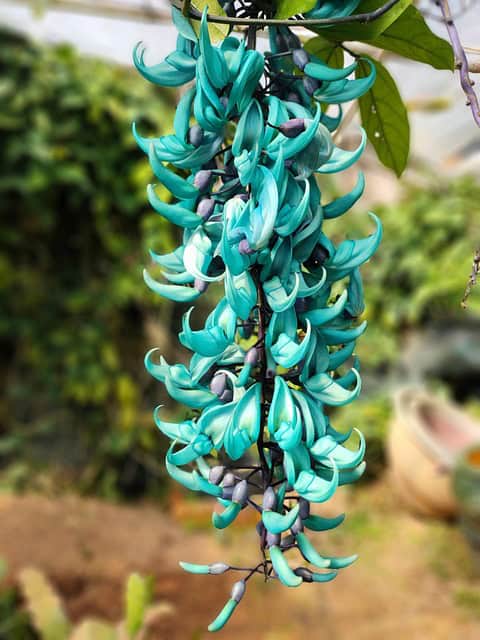
Hailing from the lush rainforests of the Philippines, the Jade Vine is a true marvel of nature. This cascading, vine-like plant boasts an array of pendant, claw-like flowers that range in color from a mesmerizing jade green to a deep, rich blue. The Jade Vine’s delicate, yet striking appearance has earned it the nickname “the emerald of the jungle.”
What makes the Jade Vine so exceptional is its rarity and the challenges it faces for survival. As a species native to a specific region, it is highly vulnerable to habitat loss and environmental changes. Deforestation, urbanization, and climate change have all contributed to the decline of this captivating plant. Conservation efforts are underway to protect the Jade Vine and ensure its continued existence, as it holds immense cultural and ecological significance for the people of the Philippines.
Parrot’s Beak (Lotus berthelotii)
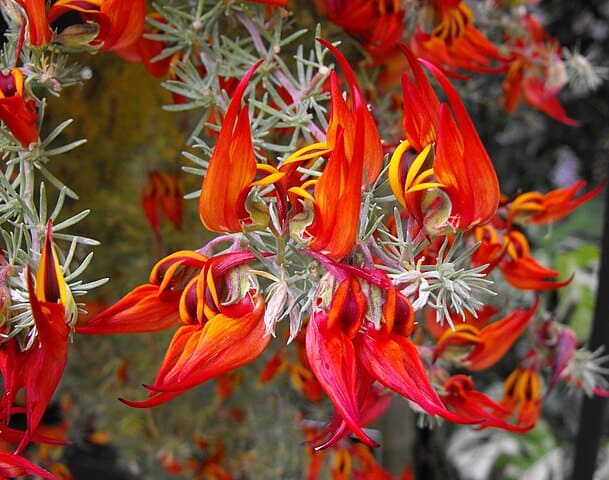
Hailing from the Canary Islands, the Parrot’s Beak, or Lotus berthelotii, is a true botanical marvel. This low-growing, succulent-like plant produces striking, beak-shaped flowers that resemble the vibrant plumage of a parrot. The petals, which range in color from deep red to orange, create a captivating contrast against the plant’s lush, green foliage.
The Parrot’s Beak is not only visually stunning but also highly adapted to its harsh, arid environment. Its succulent leaves and stems allow it to thrive in the dry, rocky terrain of the Canary Islands, where water is scarce. This resilience, however, has not shielded the Parrot’s Beak from the threats of human activity. Habitat destruction, invasive species, and climate change have all contributed to the decline of this rare and unique flower.
Black Bat Flower (Tacca chantrieri)
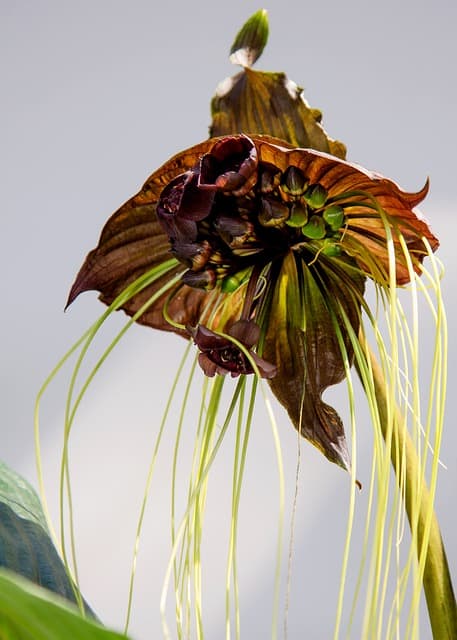
Venture into the dense, tropical forests of Southeast Asia, and you may stumble upon the otherworldly Black Bat Flower. This captivating plant, native to regions like China, Thailand, and Vietnam, boasts a striking appearance that is both mesmerizing and slightly unsettling. The Black Bat Flower’s dark, velvety petals, which resemble the wings of a bat, are complemented by long, tendril-like bracts that sway and dance in the breeze.
The Black Bat Flower’s unique appearance is not merely a visual delight; it serves a crucial purpose in the plant’s pollination process. The flower’s dark coloration and bat-like shape attract a specific species of bat, which feeds on the nectar and inadvertently carries pollen from one plant to another. This intricate relationship between the Black Bat Flower and its pollinators is a testament to the delicate balance of nature.
Hot Lips (Palicourea elata)

Nestled in the lush, tropical forests of Central and South America, the Hot Lips plant (Palicourea elata) is a true showstopper. This vibrant, shrub-like plant boasts an array of striking, lipstick-red flowers that seem to almost pout from the foliage. The “lips” of the Hot Lips flower are actually modified bracts, which serve to attract the plant’s primary pollinators – hummingbirds.
The Hot Lips plant’s remarkable appearance is not merely a visual delight; it is a testament to the intricate evolutionary adaptations that have allowed it to thrive in its native habitat. The plant’s bright red coloration and nectar-rich flowers have evolved to specifically cater to the feeding preferences of hummingbirds, which are the primary pollinators in the region. This symbiotic relationship is crucial for the plant’s reproductive success and the maintenance of the delicate ecosystem in which it resides.
Corpse Flower (Amorphophallus Titanum)
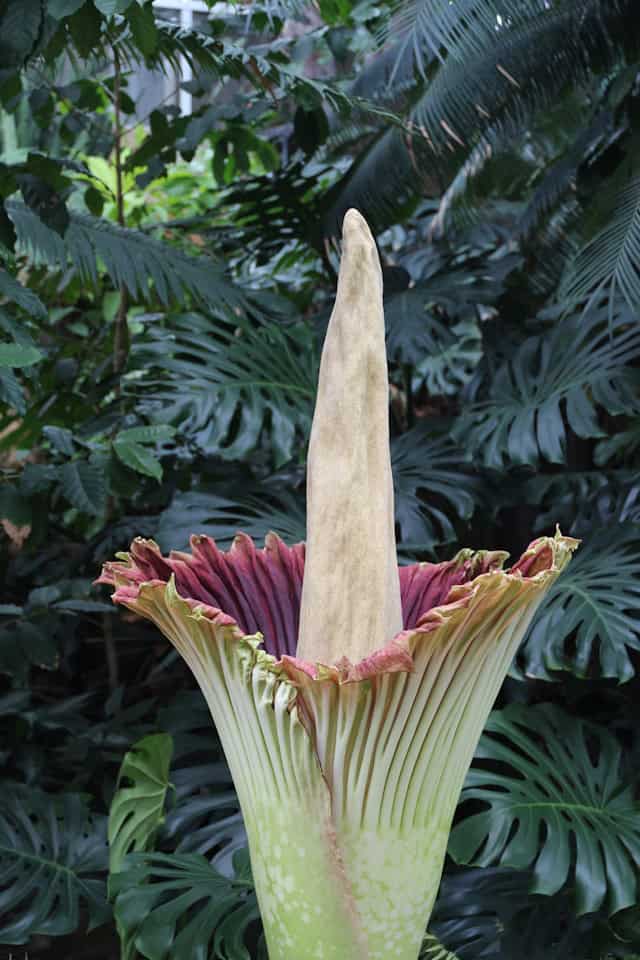
Venture into the steamy, tropical forests of Sumatra, and you may encounter one of the most remarkable and notorious flowers on the planet – the Corpse Flower (Amorphophallus Titanum). This towering, titan-sized plant is renowned for its colossal, foul-smelling inflorescence, which can reach up to 10 feet in height and emit a stench akin to rotting flesh.
The Corpse Flower’s unique and somewhat unsettling appearance is not merely a curiosity; it serves a crucial purpose in the plant’s pollination process. The flower’s deep burgundy color and putrid odor attract carrion-feeding insects, such as flies and beetles, which mistake the inflorescence for a decaying carcass. As these insects crawl over the flower’s surface, they inadvertently transfer pollen from one plant to another, ensuring the Corpse Flower’s reproductive success.
Rothschild’s Slipper Orchid (Paphiopedilum rothschildianum)

Nestled deep within the lush, tropical forests of Borneo, the Rothschild’s Slipper Orchid (Paphiopedilum rothschildianum) stands out as a true masterpiece of nature. This majestic, epiphytic orchid boasts large, slipper-shaped flowers that range in color from a vibrant yellow to a deep, rich burgundy. The plant’s intricate, sculptural blooms are further accentuated by striking, spotted petals that seem to almost glow from within.
The Rothschild’s Slipper Orchid’s remarkable appearance is not merely a visual delight; it is a testament to the plant’s highly specialized pollination mechanism. The flower’s unique shape and coloration have evolved to attract a specific species of bee, which is the plant’s primary pollinator. As the bee enters the flower’s “slipper” in search of nectar, it inadvertently collects and transfers pollen, ensuring the orchid’s reproductive success.
Attenborough’s Pitcher Plant (Nepenthes attenboroughii)

Venture into the remote, cloud-shrouded mountains of the Philippines, and you may encounter one of the most remarkable carnivorous plants on the planet – the Attenborough’s Pitcher Plant (Nepenthes attenboroughii). Named after the renowned naturalist Sir David Attenborough, this captivating species is known for its massive, pitcher-shaped traps that can grow up to 30 inches in length.
The Attenborough’s Pitcher Plant’s unique adaptations are a testament to its evolutionary ingenuity. The plant’s deep, pitcher-like structures are filled with a digestive liquid that traps and breaks down insects and other small prey. This carnivorous strategy allows the Attenborough’s Pitcher Plant to thrive in nutrient-poor, mountainous environments where traditional photosynthesis may be limited.
Kraaifontein Spiderhead (Serruria furcellata)
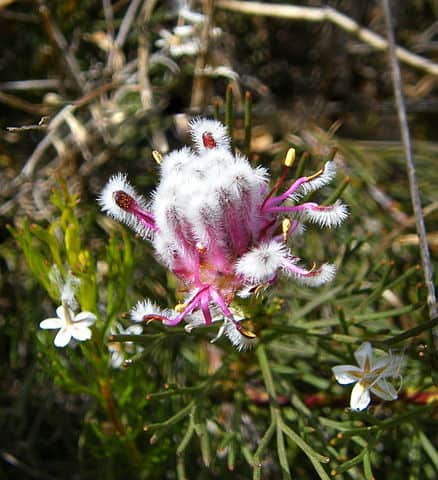
Nestled within the rugged, fynbos-covered landscapes of South Africa’s Cape Floral Region, the Kraaifontein Spiderhead (Serruria furcellata) is a true botanical gem. This delicate, shrub-like plant produces an array of intricate, spider-like flowers that seem to dance atop its slender stems. The Kraaifontein Spiderhead’s captivating blooms range in color from a soft, creamy white to a deep, rich pink, creating a stunning contrast against the plant’s lush, green foliage.
The Kraaifontein Spiderhead’s remarkable appearance is not merely a visual delight; it is a crucial adaptation that helps the plant to thrive in its harsh, fire-prone environment. The plant’s delicate, spider-like flowers are designed to quickly release their seeds in the event of a wildfire, ensuring the species’ survival and regeneration. This resilience, however, has not shielded the Kraaifontein Spiderhead from the threats of human activity, as habitat loss, invasive species, and climate change continue to pose significant challenges to its long-term survival.
American Ghost Orchid (Dendrophylax lindenii)
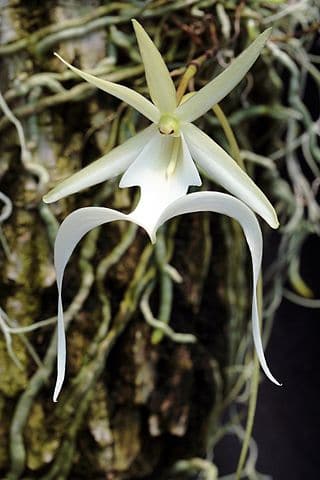
Deep within the dense, subtropical forests of Florida and the Caribbean, a ghostly apparition emerges – the American Ghost Orchid (Dendrophylax lindenii). This ethereal, epiphytic orchid is renowned for its lack of leaves, instead relying on its pale, ghostly-white flowers to photosynthesize and attract pollinators.
The American Ghost Orchid’s remarkable appearance is a testament to its highly specialized adaptations. Without the need for traditional leaves, the plant can devote its energy to producing its captivating, spider-like blooms, which can measure up to 6 inches across. These delicate flowers emit a sweet, vanilla-like fragrance that attracts the plant’s primary pollinators – moths.
Flame Lily (Gloriosa)
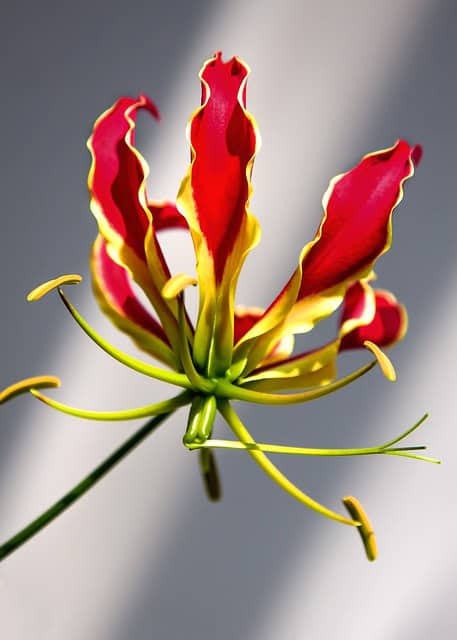
Hailing from the tropical regions of Africa and Asia, the Flame Lily (Gloriosa) is a true botanical marvel. This climbing, vine-like plant produces striking, fiery-red and yellow flowers that seem to almost glow from within. The Flame Lily’s captivating blooms are further accentuated by their unique, claw-like petals, which give the flower a sense of movement and energy.
The Flame Lily’s remarkable appearance is not merely a visual delight; it is a crucial adaptation that helps the plant to thrive in its native habitat. The flower’s vibrant coloration and nectar-rich blooms attract a variety of pollinators, including bees, butterflies, and even small birds. This symbiotic relationship is essential for the plant’s reproductive success and the maintenance of the delicate ecosystems in which it resides.
Cooke’s Koki’o (Kokia cookei)
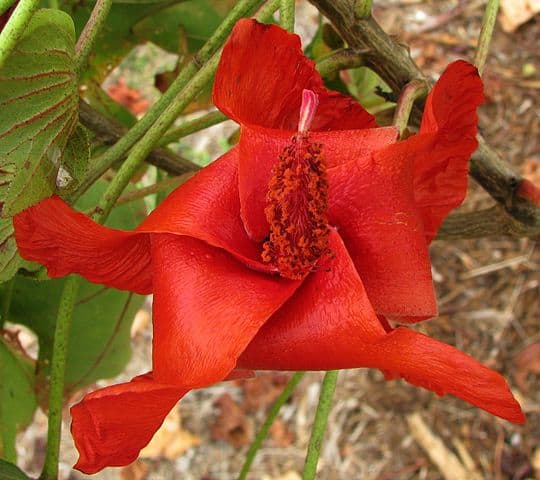
Nestled within the lush, tropical forests of Hawaii, the Cooke’s Koki’o (Kokia cookei) stands out as a true botanical rarity. This captivating, tree-like plant produces vibrant, red flowers that seem to almost glow from within, creating a stunning contrast against its dark, leathery foliage.
The Cooke’s Koki’o’s remarkable appearance is not merely a visual delight; it is a testament to the plant’s unique evolutionary adaptations. The flower’s bright red coloration and nectar-rich blooms have evolved to attract the plant’s primary pollinators – Hawaiian honeycreepers, a group of endemic, nectar-feeding birds. This symbiotic relationship is crucial for the Cooke’s Koki’o’s reproductive success and the maintenance of the delicate Hawaiian ecosystem.
Indian Pipe Flower (Monotropa uniflora)
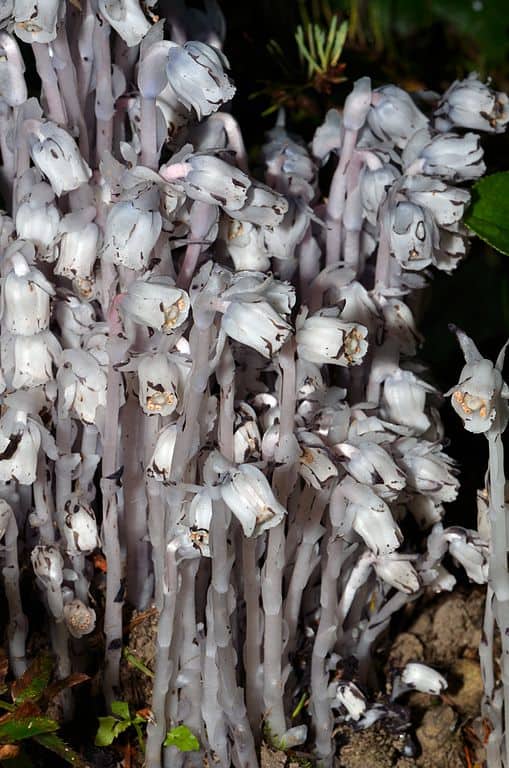
Nestled within the shaded, forest understories of North America, the Indian Pipe Flower (Monotropa uniflora) stands out as a true botanical oddity. This ghostly, white plant is devoid of chlorophyll, instead relying on a symbiotic relationship with fungi to obtain the nutrients it needs to survive. The Indian Pipe Flower’s otherworldly appearance, with its waxy, translucent stems and delicate, nodding blooms, has earned it a variety of nicknames, including “Ghost Flower” and “Corpse Flower.”
Despite its unusual characteristics, the Indian Pipe Flower is not a parasite, but rather a mycoheterotrophic plant, meaning it obtains its carbon and nutrients from the fungi it associates with, rather than through photosynthesis. This remarkable adaptation allows the plant to thrive in the low-light conditions of the forest floor, where traditional photosynthesis may be limited.
Youtan Poluo – The Udumbara Flower
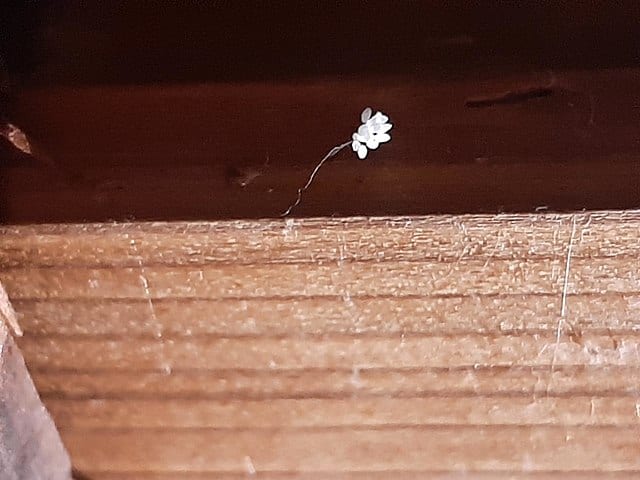
In the realm of rare and extraordinary flowers, few can match the mystique and legend surrounding the Youtan Poluo, also known as the Udumbara Flower. This captivating, ephemeral bloom is said to appear only once every 3,000 years, making it one of the rarest and most elusive flowers on the planet.
The Youtan Poluo’s remarkable appearance is a sight to behold, with its delicate, white petals and golden-yellow center. The flower is believed to have originated in ancient Buddhist texts, where it is described as a symbol of purity, enlightenment, and the rarity of true spiritual attainment. The Youtan Poluo’s fleeting nature and its association with profound spiritual significance have made it a subject of intense fascination and speculation among botanists, historians, and spiritual seekers alike.
Despite the Youtan Poluo’s legendary status, the existence of this rare flower remains a subject of debate and uncertainty. Some claim to have witnessed its elusive blooms, while others remain skeptical of its very existence. Nonetheless, the Youtan Poluo continues to captivate the imagination of people around the world, serving as a reminder of the extraordinary diversity and mystery that still exists within the natural world.
Kadupul Cactus Flower (Epiphyllum oxypetalum)
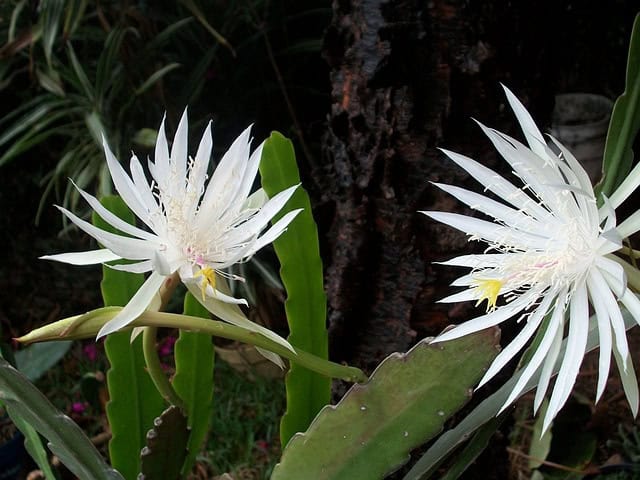
Nestled within the lush, tropical forests of Sri Lanka, the Kadupul Cactus Flower (Epiphyllum oxypetalum) stands out as one of the rarest and most coveted blooms on the planet. This captivating, nocturnal flower is renowned for its stunning, pure-white petals and its intoxicating, sweet fragrance that fills the night air. The Kadupul’s ethereal beauty, however, is matched only by its fleeting nature, as the flower blooms for just a few hours before wilting away, never to be seen again until the next season.
The Kadupul Cactus Flower’s remarkable adaptations are a testament to the plant’s evolutionary ingenuity. The flower’s nocturnal blooming cycle and its specialized pollination mechanisms, which rely on nocturnal moths, have allowed it to thrive in the dense, shaded environments of its native habitat. However, these same adaptations also make the Kadupul Cactus Flower incredibly difficult to cultivate and propagate, contributing to its rarity and the challenges it faces in the face of habitat loss and human encroachment.
Jellyfish Tree (Medusagyne oppositifolia)
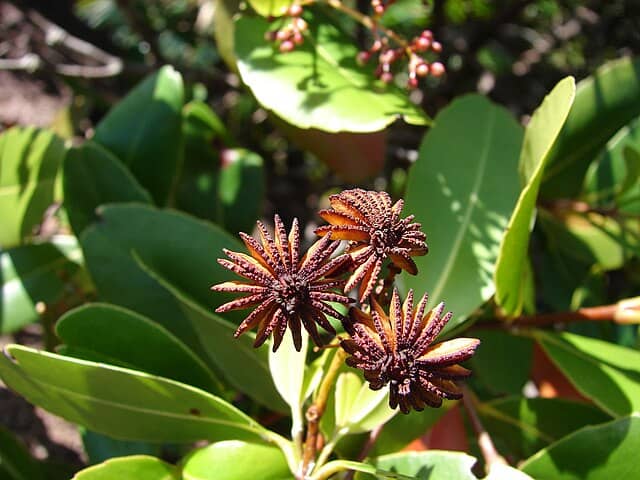
Tucked away in the remote, granite-clad mountains of the Seychelles archipelago, the Jellyfish Tree (Medusagyne oppositifolia) stands as a true botanical marvel. This captivating, tree-like plant produces a stunning array of delicate, white flowers that seem to float and dance atop its slender, tentacle-like branches, earning it the moniker “Jellyfish Tree.”
The Jellyfish Tree’s remarkable appearance is not merely a visual delight; it is a testament to the plant’s highly specialized adaptations. The flower’s intricate, tentacle-like petals and its ability to thrive in the harsh, nutrient-poor environments of its native habitat are the result of millions of years of evolutionary refinement. These adaptations have allowed the Jellyfish Tree to carve out a unique ecological niche, where it can flourish in the face of intense competition and environmental stresses.
Guzmania Lepidota
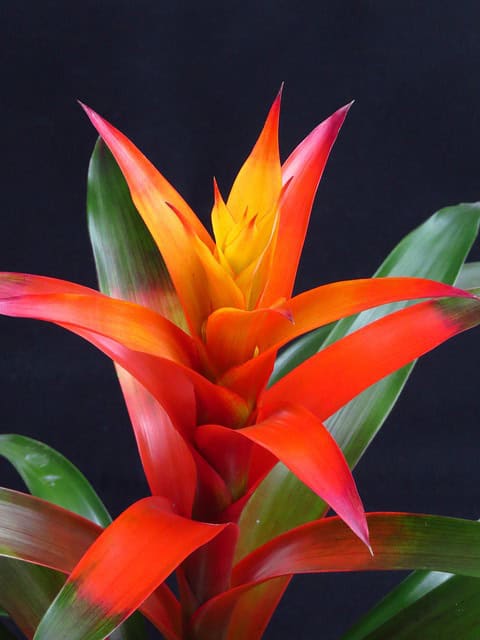
Hailing from the lush, tropical forests of Central and South America, the Guzmania Lepidota is a captivating bromeliad that stands out for its striking, vibrant blooms. This epiphytic plant produces a stunning array of scarlet-red, spoon-shaped flowers that seem to almost glow from within, creating a stunning contrast against its rosette of green, strap-like leaves.
The Guzmania Lepidota’s remarkable appearance is not merely a visual delight; it is a crucial adaptation that helps the plant to thrive in its native habitat. The flower’s bright coloration and nectar-rich blooms have evolved to attract a variety of pollinators, including hummingbirds and insects, ensuring the plant’s reproductive success and the maintenance of the delicate ecosystems in which it resides.
Chocolate Cosmos (Cosmos atrosanguineus)
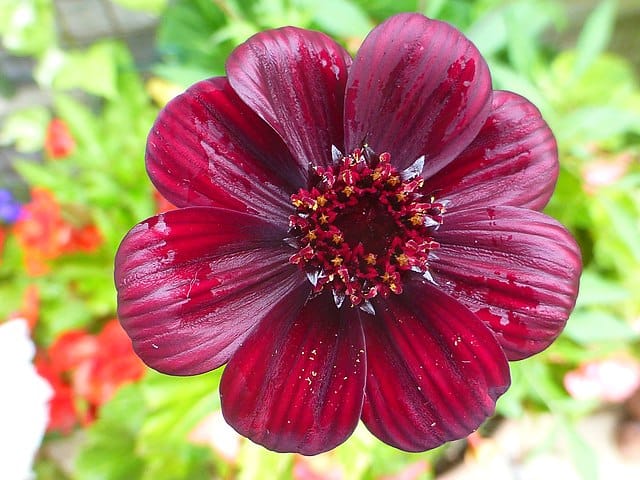
Nestled within the lush, meadows and grasslands of Mexico, the Chocolate Cosmos (Cosmos atrosanguineus) stands out as a true botanical rarity. This captivating, deep-burgundy flower not only boasts a striking appearance, but also a rich, chocolatey aroma that has earned it the nickname “Chocolate Flower.”
The Chocolate Cosmos’ remarkable scent is not merely a pleasant bonus; it is a crucial adaptation that helps the plant to attract its primary pollinators – bees and butterflies. The flower’s unique fragrance, which is reminiscent of rich, dark chocolate, serves to lure these important pollinators, ensuring the plant’s reproductive success and the maintenance of the delicate ecosystems in which it resides.
Pygmy Rwandan Waterlily (Nymphaea thermarum)
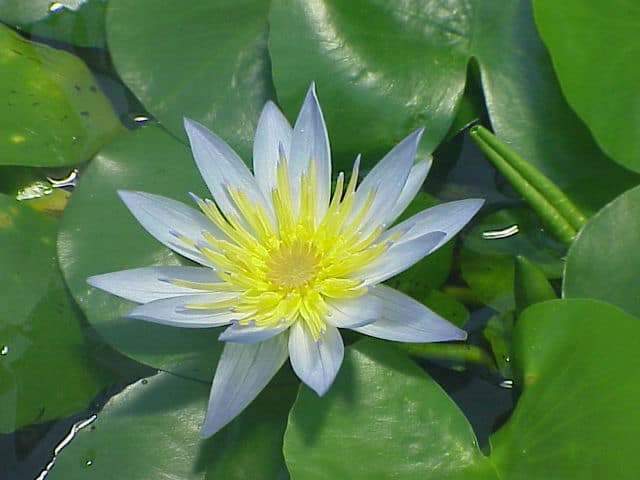
Deep within the volcanic, thermal springs of Rwanda, a botanical wonder emerges – the Pygmy Rwandan Waterlily (Nymphaea thermarum). This captivating, miniature waterlily is the smallest known flowering plant in the world, with leaves that can measure just a few centimeters in diameter.
The Pygmy Rwandan Waterlily’s remarkable size is a testament to its highly specialized adaptations. In the harsh, nutrient-poor environment of its native habitat, the plant has evolved to devote its limited resources to producing its diminutive, yet exquisite, blooms. These delicate, white flowers, which can measure just a few millimeters across, serve to attract the plant’s primary pollinators – tiny insects and aquatic creatures.
St Helena Redwood (Trochetiopsis erythroxylon)
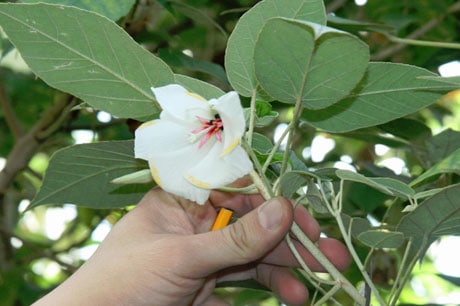
Nestled within the rugged, volcanic landscapes of the remote island of St. Helena, the St Helena Redwood (Trochetiopsis erythroxylon) stands as a true botanical marvel. This captivating, tree-like plant produces a stunning array of vibrant, red flowers that seem to almost glow from within, creating a striking contrast against its dark, leathery foliage.
The St Helena Redwood’s remarkable appearance is not merely a visual delight; it is a testament to the plant’s unique evolutionary adaptations. The flower’s bright red coloration and nectar-rich blooms have evolved to attract the plant’s primary pollinators – endemic birds and insects that have co-evolved with the Redwood over millions of years. This symbiotic relationship is crucial for the plant’s reproductive success and the maintenance of the delicate ecosystems in which it resides.
Franklin Tree (Franklinia alatamaha)
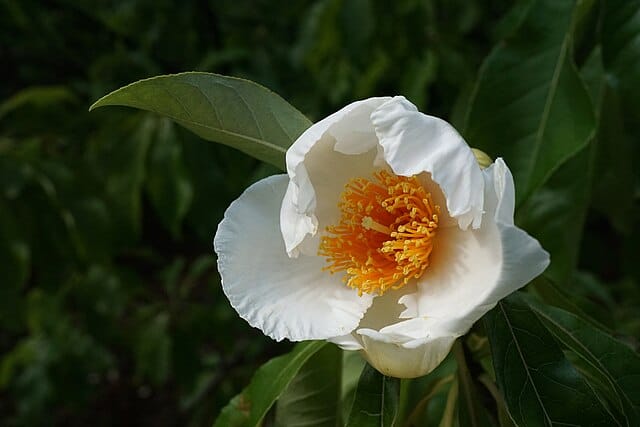
Nestled within the lush, forested regions of the southeastern United States, the Franklin Tree (Franklinia alatamaha) stands as a true botanical rarity. This captivating, deciduous tree produces a stunning array of delicate, white flowers that bloom in late summer, creating a breathtaking contrast against its vibrant, autumnal foliage.
The Franklin Tree’s remarkable history is as intriguing as its appearance. The plant was first discovered in 1765 by the renowned botanist John Bartram, who named it in honor of his friend, Benjamin Franklin. Despite its initial discovery, the Franklin Tree was never again observed in the wild, leading many to believe that it had gone extinct. Remarkably, the species was rediscovered in the 1930s, but only a few cultivated specimens remained, making the Franklin Tree one of the rarest plants on Earth.
Yellow Fatu (Abutilon pitcairnense)
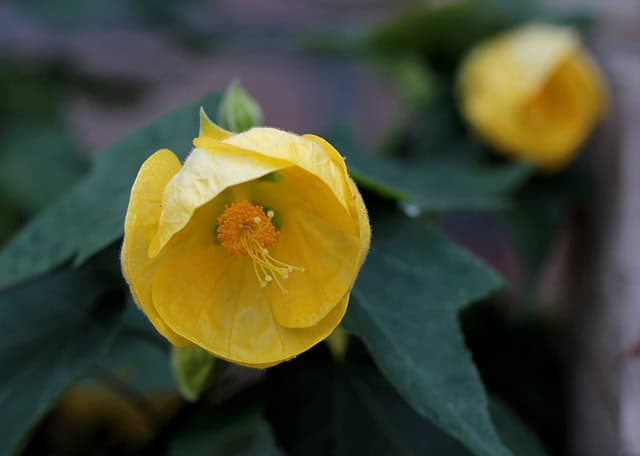
Tucked away in the remote, volcanic landscapes of the Pitcairn Islands, the Yellow Fatu (Abutilon pitcairnense) stands as a true botanical marvel. This captivating, shrub-like plant produces a stunning array of vibrant, yellow flowers that seem to almost glow from within, creating a striking contrast against its dark, velvety foliage.
The Yellow Fatu’s remarkable appearance is not merely a visual delight; it is a testament to the plant’s highly specialized adaptations. The flower’s bright coloration and nectar-rich blooms have evolved to attract the plant’s primary pollinators – endemic birds and insects that have co-evolved with the Yellow Fatu over countless generations. This symbiotic relationship is crucial for the plant’s reproductive success and the maintenance of the delicate ecosystems in which it resides.
Spiny Red Coral Tree (Erythrina schliebenii)
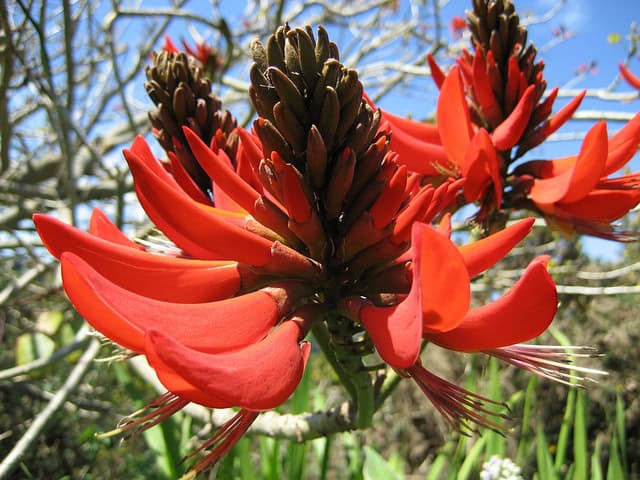
Nestled within the rugged, coastal forests of Tanzania, the Spiny Red Coral Tree (Erythrina schliebenii) stands as a true botanical marvel. This captivating, tree-like plant produces a stunning array of vibrant, red flowers that seem to almost glow from within, creating a striking contrast against its thorny, green foliage.
The Spiny Red Coral Tree’s remarkable appearance is not merely a visual delight; it is a testament to the plant’s unique evolutionary adaptations. The flower’s bright red coloration and nectar-rich blooms have evolved to attract the plant’s primary pollinators – endemic birds and insects that have co-evolved with the Coral Tree over millions of years. This symbiotic relationship is crucial for the plant’s reproductive success and the maintenance of the delicate ecosystems in which it resides.
Casey’s Larkspur (Delphinium caseyi)
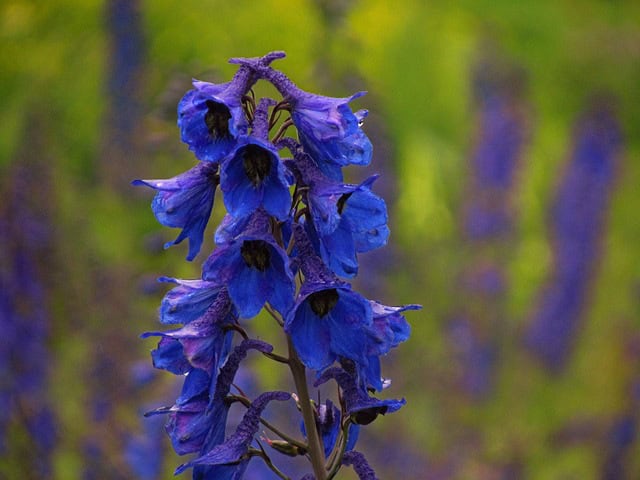
Nestled within the rugged, alpine landscapes of the western United States, Casey’s Larkspur (Delphinium caseyi) stands as a true botanical rarity. This captivating, perennial wildflower produces a stunning array of vibrant, blue-purple blooms that seem to almost glow from within, creating a breathtaking contrast against the plant’s deeply-lobed, green foliage.
The Casey’s Larkspur’s remarkable appearance is not merely a visual delight; it is a testament to the plant’s highly specialized adaptations. The flower’s bright coloration and intricate, spur-like petals have evolved to attract the plant’s primary pollinators – bumblebees and other specialized insects that are capable of navigating the plant’s complex floral structure. This symbiotic relationship is crucial for the Casey’s Larkspur’s reproductive success and the maintenance of the delicate alpine ecosystems in which it resides.
Nuragica Columbine (Aquilegia nuragica)
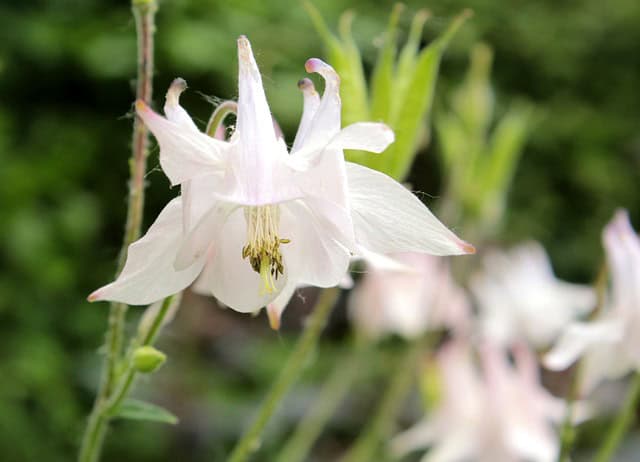
Tucked away in the rugged, mountainous regions of Sardinia, the Nuragica Columbine (Aquilegia nuragica) stands as a true botanical marvel. This captivating, perennial wildflower produces a stunning array of delicate, bell-shaped flowers that seem to almost float above its deeply-lobed, green foliage, creating a mesmerizing display.
The Nuragica Columbine’s remarkable appearance is not merely a visual delight; it is a testament to the plant’s highly specialized adaptations. The flower’s intricate, spur-like petals and its ability to thrive in the harsh, nutrient-poor environments of its native habitat are the result of millions of years of evolutionary refinement. These adaptations have allowed the Nuragica Columbine to carve out a unique ecological niche, where it can flourish in the face of intense competition and environmental stresses.
Talipot Palm (Corypha umbraculifera)
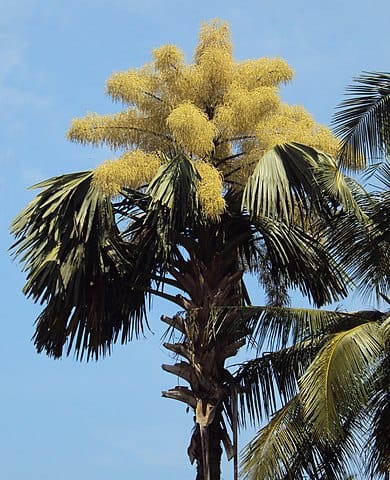
Hailing from the lush, tropical forests of southern Asia, the Talipot Palm (Corypha umbraculifera) stands out as a true botanical marvel. This captivating, tree-like plant produces a stunning array of delicate, white flowers that bloom in a massive, terminal inflorescence, creating a breathtaking display that can reach up to 20 feet in height.
The Talipot Palm’s remarkable appearance is not merely a visual delight; it is a testament to the plant’s highly specialized adaptations. The flower’s intricate, branching structure and its ability to produce such a massive, energy-intensive bloom are the result of millions of years of evolutionary refinement. These adaptations have allowed the Talipot Palm to thrive in the face of intense competition and environmental stresses, carving out a unique ecological niche within its native habitat.
Siempreviva de Guelgue (Limonium spectabile)
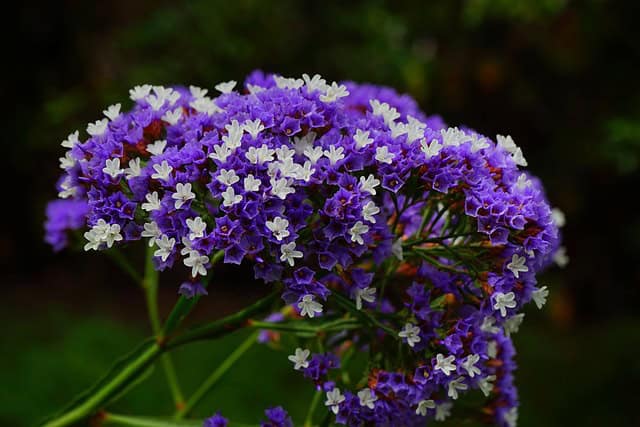
Nestled within the rugged, coastal landscapes of the Canary Islands, the Siempreviva de Guelgue (Limonium spectabile) stands as a true botanical marvel. This captivating, perennial wildflower produces a stunning array of delicate, lavender-colored blooms that seem to float above its silvery-green foliage, creating a mesmerizing display.
The Siempreviva de Guelgue’s remarkable appearance is not merely a visual delight; it is a testament to the plant’s highly specialized adaptations. The flower’s intricate, papery petals and its ability to thrive in the harsh, saline environments of its native habitat are the result of millions of years of evolutionary refinement. These adaptations have allowed the Siempreviva de Guelgue to carve out a unique ecological niche, where it can flourish in the face of intense competition and environmental stresses.
Middlemist Red Camellia (Camellia japonica)
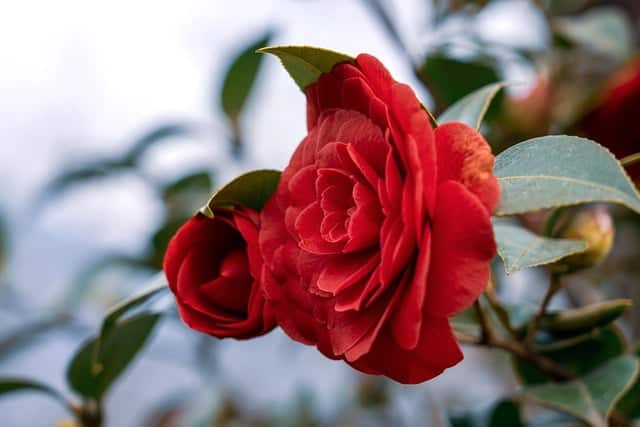
Hailing from the lush, temperate forests of China, the Middlemist Red Camellia (Camellia japonica) stands out as a true botanical rarity. This captivating, evergreen shrub produces a stunning array of deep-red, rose-like flowers that seem to almost glow from within, creating a breathtaking display.
The Middlemist Red Camellia’s remarkable appearance is not merely a visual delight; it is a testament to the plant’s highly specialized adaptations. The flower’s intricate, layered petals and its ability to thrive in the shaded, nutrient-rich environments of its native habitat are the result of millions of years of evolutionary refinement. These adaptations have allowed the Middlemist Red Camellia to carve out a unique ecological niche, where it can flourish in the face of intense competition and environmental stresses.
Juliet Rose
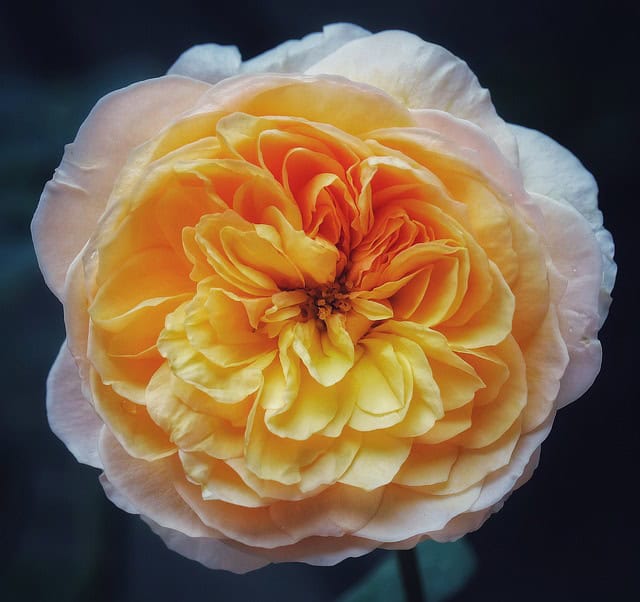
Emerging from the world-renowned rose breeding program of David Austin, the Juliet Rose stands as a true botanical marvel. This captivating, hybrid rose produces a stunning array of soft, peach-colored blooms that seem to almost glow from within, creating a mesmerizing display.
The Juliet Rose’s remarkable appearance is not merely a visual delight; it is a testament to the plant’s highly specialized adaptations. The flower’s intricate, layered petals and its ability to thrive in a wide range of growing conditions are the result of decades of meticulous breeding and selection. These adaptations have allowed the Juliet Rose to become one of the most sought-after and coveted roses in the world, captivating gardeners and floral enthusiasts alike.
Night-Blooming Cereus (Selenicereus grandiflorus)
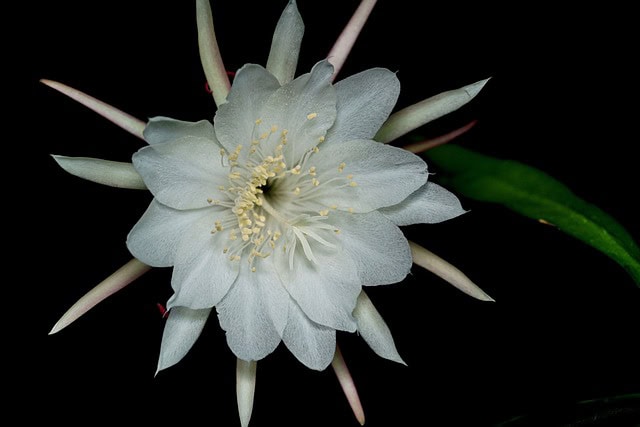
Hailing from the arid, desert landscapes of Central and South America, the Night-Blooming Cereus (Selenicereus grandiflorus) stands as a true botanical marvel. This captivating, cactus-like plant produces a stunning array of massive, white flowers that bloom for a single night, creating a mesmerizing display that has captivated the imaginations of botanists and nature enthusiasts alike.
The Night-Blooming Cereus’ remarkable appearance is not merely a visual delight; it is a testament to the plant’s highly specialized adaptations. The flower’s intricate, waxy petals and its ability to thrive in the harsh, drought-prone environments of its native habitat are the result of millions of years of evolutionary refinement. These adaptations have allowed the Night-Blooming Cereus to carve out a unique ecological niche, where it can flourish in the face of intense competition and environmental stresses.
Hawaiian Hibiscus (Hibiscus arnottianus subsp. immaculatus)
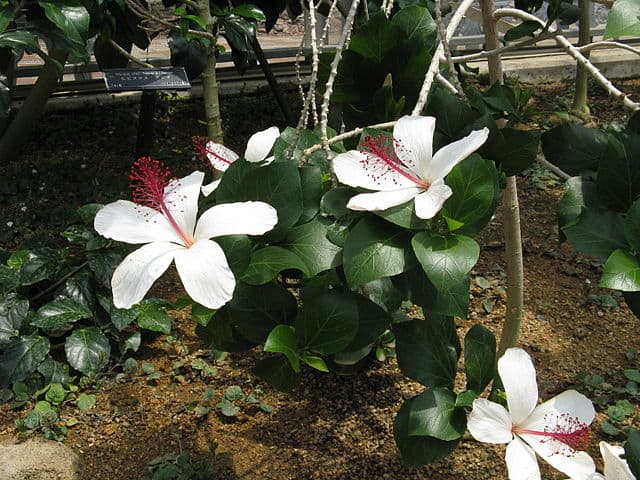
Nestled within the lush, tropical landscapes of the Hawaiian Islands, the Hawaiian Hibiscus (Hibiscus arnottianus subsp. immaculatus) stands as a true botanical marvel. This captivating, shrub-like plant produces a stunning array of delicate, white flowers that seem to almost glow from within, creating a breathtaking display against its vibrant, green foliage.
The Hawaiian Hibiscus’ remarkable appearance is not merely a visual delight; it is a testament to the plant’s highly specialized adaptations. The flower’s intricate, layered petals and its ability to thrive in the nutrient-rich, humid environments of its native habitat are the result of millions of years of evolutionary refinement. These adaptations have allowed the Hawaiian Hibiscus to carve out a unique ecological niche, where it can flourish in the face of intense competition and environmental stresses.
Lady’s Slipper Orchid (Cypripedioideae)

Nestled within the lush, forested regions of North America and Eurasia, the Lady’s Slipper Orchid (Cypripedioideae) stands as a true botanical marvel. This captivating, perennial plant produces a stunning array of delicate, slipper-shaped flowers that seem to almost float above its vibrant, green foliage, creating a mesmerizing display.
The Lady’s Slipper Orchid’s remarkable appearance is not merely a visual delight; it is a testament to the plant’s highly specialized adaptations. The flower’s intricate, pouch-like structure and its ability to attract specific pollinator species are the result of millions of years of evolutionary refinement. These adaptations have allowed the Lady’s Slipper Orchid to carve out a unique ecological niche, where it can flourish in the face of intense competition and environmental stresses.
White American Waterlily (Nymphaea odorata)
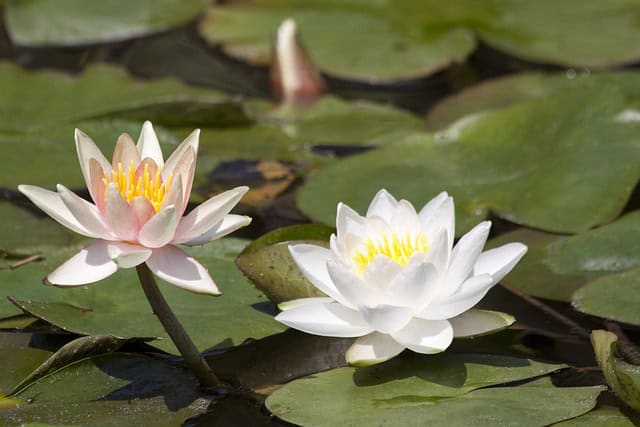
Floating serenely upon the still waters of North America, the White American Waterlily (Nymphaea odorata) stands as a true botanical marvel. This captivating, aquatic plant produces a stunning array of large, pristine white flowers that seem to almost glow from within, creating a mesmerizing display against its broad, floating leaves.
The White American Waterlily’s remarkable appearance is not merely a visual delight; it is a testament to the plant’s highly specialized adaptations. The flower’s intricate, layered petals and its ability to thrive in the nutrient-rich, slow-moving waterways of its native habitat are the result of millions of years of evolutionary refinement. These adaptations have allowed the White American Waterlily to carve out a unique ecological niche, where it can flourish in the face of intense competition and environmental stresses.
Brugmansia vulcanicola
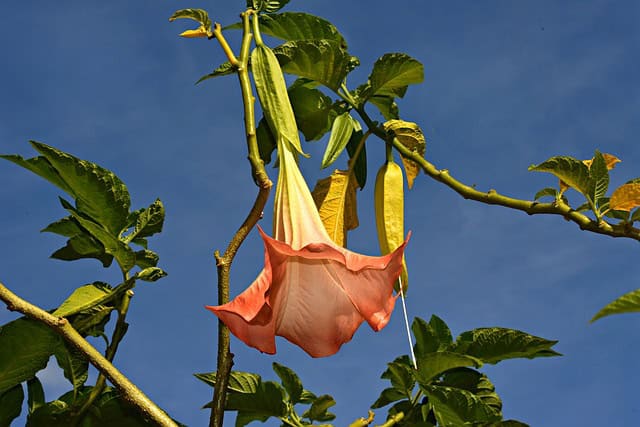
Hailing from the lush, tropical forests of South America, the Brugmansia vulcanicola stands as a true botanical marvel. This captivating, tree-like plant produces a stunning array of large, pendulous flowers that seem to almost glow from within, creating a mesmerizing display that has captivated the imaginations of botanists and nature enthusiasts alike.
The Brugmansia vulcanicola’s remarkable appearance is not merely a visual delight; it is a testament to the plant’s highly specialized adaptations. The flower’s intricate, trumpet-shaped structure and its ability to thrive in the nutrient-rich, humid environments of its native habitat are the result of millions of years of evolutionary refinement. These adaptations have allowed the Brugmansia vulcanicola to carve out a unique ecological niche, where it can flourish in the face of intense competition and environmental stresses.
Cayman Sage (Salvia caymanensis)
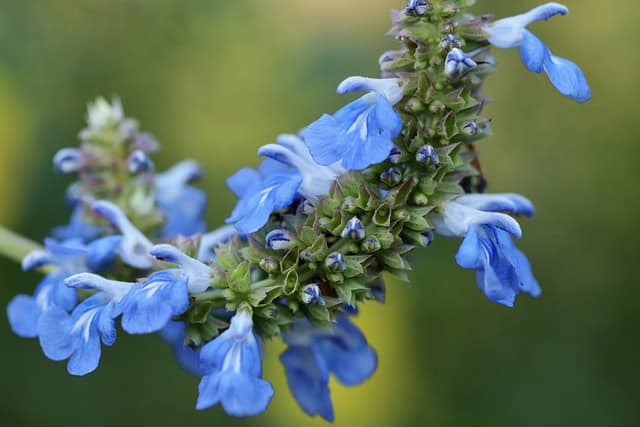
Nestled within the sun-drenched, coastal landscapes of the Cayman Islands, the Cayman Sage (Salvia caymanensis) stands as a true botanical marvel. This captivating, perennial herb produces a stunning array of vibrant, purple-blue flowers that seem to almost glow from within, creating a mesmerizing display against its aromatic, silvery-green foliage.
The Cayman Sage’s remarkable appearance is not merely a visual delight; it is a testament to the plant’s highly specialized adaptations. The flower’s intricate, two-lipped structure and its ability to thrive in the hot, dry environments of its native habitat are the result of millions of years of evolutionary refinement. These adaptations have allowed the Cayman Sage to carve out a unique ecological niche, where it can flourish in the face of intense competition and environmental stresses.
Stinking Corpse Lily (Rafflesia arnoldii)
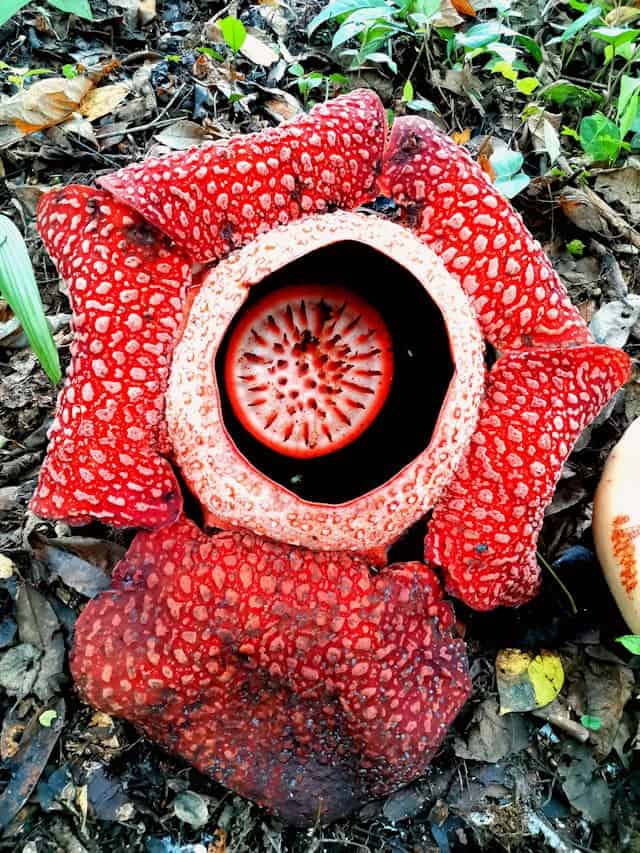
Emerging from the lush, tropical forests of Southeast Asia, the Stinking Corpse Lily (Rafflesia arnoldii) stands as a true botanical marvel. This captivating, parasitic plant produces a stunning array of massive, red-and-white flowers that seem to almost defy the laws of nature, creating a mesmerizing display that has captivated the imaginations of botanists and nature enthusiasts alike.
The Stinking Corpse Lily’s remarkable appearance is not merely a visual delight; it is a testament to the plant’s highly specialized adaptations. The flower’s intricate, fleshy structure and its ability to thrive as a parasitic organism, drawing nutrients from its host plant, are the result of millions of years of evolutionary refinement. These adaptations have allowed the Stinking Corpse Lily to carve out a unique ecological niche, where it can flourish in the face of intense competition and environmental stresses.
Western Underground Orchid (Rhizanthella gardneri)
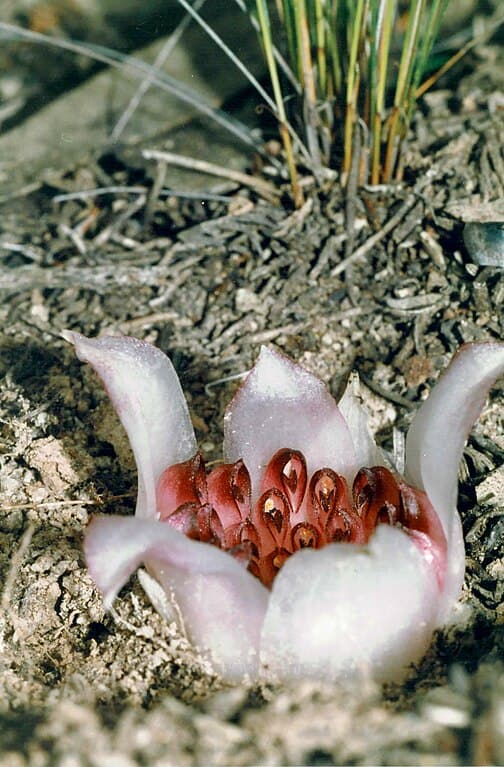
Nestled deep within the arid, sandy soils of Western Australia, the Western Underground Orchid (Rhizanthella gardneri) stands as a true botanical marvel. This captivating, subterranean plant produces a stunning array of delicate, pink flowers that seem to almost glow from within, creating a mesmerizing display that has captivated the imaginations of botanists and nature enthusiasts alike.
The Western Underground Orchid’s remarkable appearance is not merely a visual delight; it is a testament to the plant’s highly specialized adaptations. The flower’s intricate, underground structure and its ability to thrive in the nutrient-poor, arid environments of its native habitat are the result of millions of years of evolutionary refinement. These adaptations have allowed the Western Underground Orchid to carve out a unique ecological niche, where it can flourish in the face of intense competition and environmental stresses.
Ghost Orchid (Epipogium aphyllum)
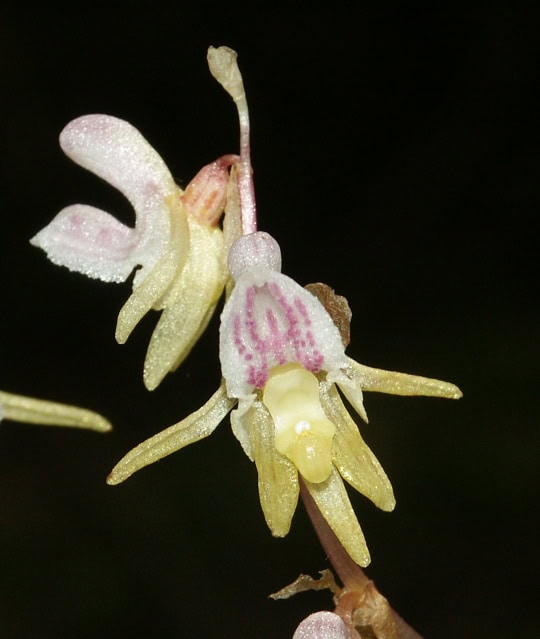
Emerging from the dense, shaded forests of Europe and Asia, the Ghost Orchid (Epipogium aphyllum) stands as a true botanical marvel. This captivating, ghostly-white plant produces a stunning array of delicate, translucent flowers that seem to almost float above the forest floor, creating a mesmerizing display that has captivated the imaginations of botanists and nature enthusiasts alike.
The Ghost Orchid’s remarkable appearance is not merely a visual delight; it is a testament to the plant’s highly specialized adaptations. The flower’s intricate, parasitic structure and its ability to thrive in the nutrient-poor, shaded environments of its native habitat are the result of millions of years of evolutionary refinement. These adaptations have allowed the Ghost Orchid to carve out a unique ecological niche, where it can flourish in the face of intense competition and environmental stresses.
Gibraltar Campion (Silene tomentosa)

Perched atop the rugged, windswept cliffs of Gibraltar, the Gibraltar Campion (Silene tomentosa) is a true botanical marvel. This low-growing, cushion-forming plant produces delicate, white flowers that seem to defy the harsh, arid environment in which it thrives.
The Gibraltar Campion’s remarkable resilience is a testament to its evolutionary adaptations. The plant’s dense, woolly foliage helps to trap moisture and protect it from the intense sun and wind of its coastal habitat. Its deep, taproot system allows it to access water and nutrients deep within the rocky soil, ensuring its survival in the face of drought and other environmental stressors.
Iris antilibanotica
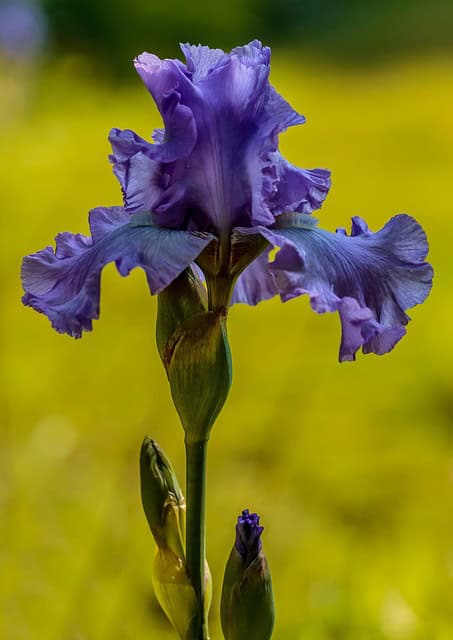
Nestled within the rugged, mountainous landscapes of Lebanon, the Iris antilibanotica is a true botanical gem. This delicate, iris-like plant produces stunning, violet-blue flowers that seem to defy the harsh, arid environment in which it thrives. The Iris antilibanotica’s remarkable resilience is a testament to its evolutionary adaptations, which have allowed it to survive and thrive in the face of extreme temperatures, limited water availability, and the constant threat of wildfire.
The Iris antilibanotica’s captivating appearance is not merely a visual delight; it is a crucial adaptation that helps the plant to attract its primary pollinators – bees and butterflies. The flower’s vibrant coloration and nectar-rich blooms serve to lure these important pollinators, ensuring the plant’s reproductive success and the maintenance of the delicate ecosystems in which it resides.





